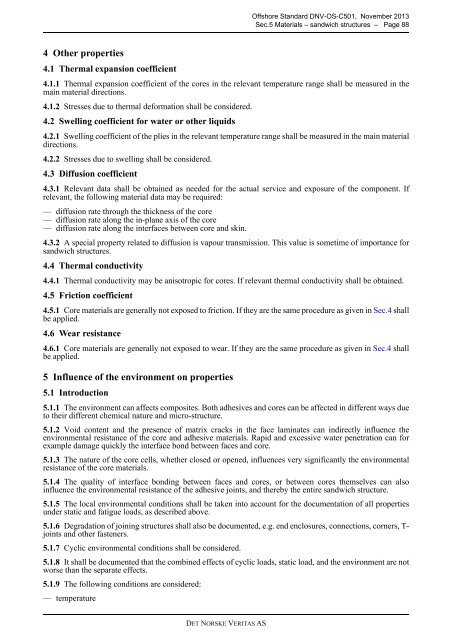OS-C501
You also want an ePaper? Increase the reach of your titles
YUMPU automatically turns print PDFs into web optimized ePapers that Google loves.
Offshore Standard DNV-<strong>OS</strong>-<strong>C501</strong>, November 2013<br />
Sec.5 Materials – sandwich structures – Page 88<br />
4 Other properties<br />
4.1 Thermal expansion coefficient<br />
4.1.1 Thermal expansion coefficient of the cores in the relevant temperature range shall be measured in the<br />
main material directions.<br />
4.1.2 Stresses due to thermal deformation shall be considered.<br />
4.2 Swelling coefficient for water or other liquids<br />
4.2.1 Swelling coefficient of the plies in the relevant temperature range shall be measured in the main material<br />
directions.<br />
4.2.2 Stresses due to swelling shall be considered.<br />
4.3 Diffusion coefficient<br />
4.3.1 Relevant data shall be obtained as needed for the actual service and exposure of the component. If<br />
relevant, the following material data may be required:<br />
— diffusion rate through the thickness of the core<br />
— diffusion rate along the in-plane axis of the core<br />
— diffusion rate along the interfaces between core and skin.<br />
4.3.2 A special property related to diffusion is vapour transmission. This value is sometime of importance for<br />
sandwich structures.<br />
4.4 Thermal conductivity<br />
4.4.1 Thermal conductivity may be anisotropic for cores. If relevant thermal conductivity shall be obtained.<br />
4.5 Friction coefficient<br />
4.5.1 Core materials are generally not exposed to friction. If they are the same procedure as given in Sec.4 shall<br />
be applied.<br />
4.6 Wear resistance<br />
4.6.1 Core materials are generally not exposed to wear. If they are the same procedure as given in Sec.4 shall<br />
be applied.<br />
5 Influence of the environment on properties<br />
5.1 Introduction<br />
5.1.1 The environment can affects composites. Both adhesives and cores can be affected in different ways due<br />
to their different chemical nature and micro-structure.<br />
5.1.2 Void content and the presence of matrix cracks in the face laminates can indirectly influence the<br />
environmental resistance of the core and adhesive materials. Rapid and excessive water penetration can for<br />
example damage quickly the interface bond between faces and core.<br />
5.1.3 The nature of the core cells, whether closed or opened, influences very significantly the environmental<br />
resistance of the core materials.<br />
5.1.4 The quality of interface bonding between faces and cores, or between cores themselves can also<br />
influence the environmental resistance of the adhesive joints, and thereby the entire sandwich structure.<br />
5.1.5 The local environmental conditions shall be taken into account for the documentation of all properties<br />
under static and fatigue loads, as described above.<br />
5.1.6 Degradation of joining structures shall also be documented, e.g. end enclosures, connections, corners, T-<br />
joints and other fasteners.<br />
5.1.7 Cyclic environmental conditions shall be considered.<br />
5.1.8 It shall be documented that the combined effects of cyclic loads, static load, and the environment are not<br />
worse than the separate effects.<br />
5.1.9 The following conditions are considered:<br />
— temperature<br />
DET NORSKE VERITAS AS



